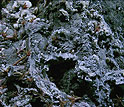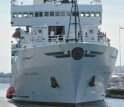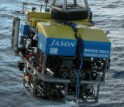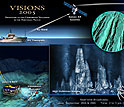News Release 05-166
Scientists to Use HDTV for a High-Definition Look at Surreal Sea Floor
Public can see broadcasts on cable, dish and Internet
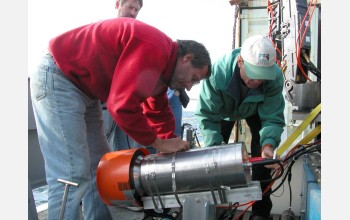
Scienitsts prepare the high-definition TV camera for loading onto a remotely operated vehicle.
September 23, 2005
This material is available primarily for archival purposes. Telephone numbers or other contact information may be out of date; please see current contact information at media contacts.
Ocean scientists are planning for the first time to use a high-definition (HD) television camera for live views of an area of the sea floor that has been twisted by earthquakes and volcanic eruptions and is dotted with eerie spires and chimneys venting water as hot as 700 degrees Fahrenheit.
On Sept. 27 and 28, the team will broadcast images from the Endeavour Segment of the Juan de Fuca Ridge on the sea floor 200 miles off the coast of Washington state and British Columbia. The transmissions are the first from the sea floor anywhere in the world to be broadcast live in HD video, which gives 7 to 10 times the clarity of standard definition.
Called VISIONS '05, for Visually Integrated Science for Interactive Ocean Networked Systems, the expedition is studying how tectonic-plate interaction can support exotic and ancient microbial life forms deep within the sea floor. Instruments, cameras and robots are being used to study the unusual microorganisms that flourish there.
The expedition is funded by the W.M. Keck Foundation, the National Science Foundation (NSF) and UW, and is using the research vessel Thomas G. Thompson and two remotely operated submersibles from the Woods Hole Oceanographic Institution.
Plans call for real-time, HD video from the sea floor to be transmitted from the remotely operated vehicle, Jason II, back to the Thompson through a 6-mile-long electro-optical tether. Weather permitting, an onboard engineering-production crew from the ResearchChannel will produce a high-definition program on Sept. 27 and 28, 2005, using shipboard and live, sub-sea HD imagery. Scientists from the ship and in a Seattle studio plan to narrate the live broadcasts from 5 P.M. to 7 P.M., EDT, on Sept. 27 and from 5 P.M. to 6 P.M, EDT, on Sept. 28.
"These broadcasts will give students and the general public a rare glimpse of the wonders of the ocean depths," said Marge Cavanaugh, deputy assistant director for geosciences at NSF, "and allow them to discover what draws oceanographers, geologists and biologists to careers in the geosciences."
The Endeavour Segment is one of the most geologically and biologically active sites in the global network of mid-ocean ridges and represents one of the most extreme environments on Earth, say University of Washington (UW) oceanographers John Delaney and Deborah Kelley, chief scientists of the Sept. 1-to-Oct. 4 expedition.
While the public broadcasts are available only in standard-definition--the same quality as regular television--UWTV and NSF are pioneering the broadcast of live high-definition video from the sea floor to selected research groups and sites in six countries capable of handling the high-bandwidth Internet data, said Michael Wellings, director of engineering at UWTV.
"This crisp resolution dramatically enhances a scientist's ability to operate in remote environments," Kelley says. "The incredible quality of the video will soon allow the public to connect with scientists online as they conduct their experiments in the deep sea"
Television viewers can see the hour-long broadcasts on ResearchChannel (channel 9400 for subscribers of Dish Network). The live broadcasts, sponsored by NSF, ResearchChannel and UWTV, are weather-dependent because storms could prevent the launch of the remotely operated vehicle that carries the underwater camera to the sea floor.
"This broadcast provides an example of how the excitement of scientific discovery can be shared with a global audience," said Delaney. "Even 2 years ago, we could not have transmitted high-definition quality imagery via satellite from a ship."
Daily updates about the expedition are posted at http://www.visions05.washington.edu/.
Computer users can see the live webcast on:
NSF's Web site
ResearchChannel Web site
UWTV's Web site
-NSF-
-
A high-definition video camera gives seven to 10 times the clarity of standard definition.
Credit and Larger Version -
The research vessel Thomas G. Thompson hosts a variety of remotely operated vehicles.
Credit and Larger Version -
Jason II is a robotic vehicle tethered to the vessel Thompson by a fiber optic cable.
Credit and Larger Version -
VISIONS '05 studies undersea hot springs associated with volcanoes of the Juan de Fuca Ridge.
Credit and Larger Version
Media Contacts
Cheryl Dybas, NSF, (703) 292-7734, email: cdybas@nsf.gov
Sandra Hines, UW, (206) 543-2580, email: shines@u.washington.edu
Related Websites
Seafloor Science Special Report: http://www.nsf.gov/news/special_reports/sfs/index.jsp
The U.S. National Science Foundation propels the nation forward by advancing fundamental research in all fields of science and engineering. NSF supports research and people by providing facilities, instruments and funding to support their ingenuity and sustain the U.S. as a global leader in research and innovation. With a fiscal year 2023 budget of $9.5 billion, NSF funds reach all 50 states through grants to nearly 2,000 colleges, universities and institutions. Each year, NSF receives more than 40,000 competitive proposals and makes about 11,000 new awards. Those awards include support for cooperative research with industry, Arctic and Antarctic research and operations, and U.S. participation in international scientific efforts.
Connect with us online
NSF website: nsf.gov
NSF News: nsf.gov/news
For News Media: nsf.gov/news/newsroom
Statistics: nsf.gov/statistics/
Awards database: nsf.gov/awardsearch/
Follow us on social
Twitter: twitter.com/NSF
Facebook: facebook.com/US.NSF
Instagram: instagram.com/nsfgov

